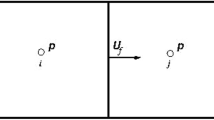Abstract
Highly accurate finite-difference schemes that are widely used in computational aeroacoustics and referred to as dispersion-relation-preserving (DRP) schemes are adapted for the simulation of viscous flows. The main result consists in the construction and verification of numerical boundary conditions on a solid body, artificial boundaries, and on their interface. Calculations are performed for several test problems, including dissipation of the Lamb–Oseen vortex and decay of the Taylor–Green vortex in two-and three-dimensional cases and in infinite and semi-infinite (open-outlet) plane channels.
Similar content being viewed by others
References
C. K. W. Tam and J. C. Webb, “Dispersion-relation-preserving finite difference schemes for computational acoustics,” J. Comput. Phys. 107, 262–281 (1993).
C. Bogey and C. Bailly, “A family of low dispersive and low dissipative explicit schemes for flow and noise computations,” J. Comput. Phys. 194, 194–214 (2004).
C. K. W. Tam, “Computational aeroacoustics: an overview of computational challenges and applications,” Int. J. Comput. Fluid Dyn. 18, 547–567 (2004).
C. K. W. Tam and Zh. Dong, “Wall boundary conditions for high-order finite-difference schemes in computational aeroacoustics,” Theor. Comput. Fluid Dyn. 6, 303–322 (1994).
C. Bogey, N. Cacqueray, and C. Bailly, “A shock-capturing methodology based on adaptive spatial filtering for high-order non-linear computations,” J. Comput. Phys. 228, 1447–1465 (2009).
J. Berland, C. Bogey, O. Marsden, and C. Bailly, “High-order, low dispersive and low dissipative explicit schemes for multiple-scale and boundary problems,” J. Comput. Phys. 224, 637–662 (2007).
J. W. Kim, “Optimised boundary compact finite difference schemes for computational aeroacoustics,” J. Comput. Phys. 225, 995–1019 (2007).
L. W. Dorodnicyn, “Artificial boundary conditions for high-accuracy aeroacoustic algorithms,” SIAM J. Sci. Comput. 32, 1950–1979 (2010).
L. V. Dorodnitsyn, “High-accuracy finite-difference boundary conditions for two-dimensional aeroacoustic problems,” Mat. Model. 23 (11), 131–155 (2011).
M. B. Giles, “Nonreflecting boundary conditions for Euler equation calculations,” AIAA J. 28, 2050–2058 (1990).
G. W. Hedstrom, “Nonreflecting boundary conditions for nonlinear hyperbolic systems,” J. Comput. Phys. 30, 222–237 (1979).
L. V. Dorodnitsyn, “Transparent boundary conditions for systems of equations of gas dynamics,” Comput. Math. Math. Phys. 42, 499–525 (2002).
L. V. Dorodnitsyn, “Artificial boundary conditions for numerical simulation of subsonic gas flows,” Comput. Math. Math. Phys. 45, 1209–1234 (2005).
M. Calvo and J. M. Franco, L. Randez, “A new minimum storage Runge-Kutta scheme for computational acoustics,” J. Comput. Phys. 211, 1–12 (2004).
B. Engquist and A. Majda, “Absorbing boundary conditions for the numerical simulation of waves,” Math. Comput. 31, 629–651 (1977).
L. V. Dorodnicyn, “Nonreflecting boundary conditions and numerical simulation of external flows,” Comput. Math. Math. Phys. 51, 143–159 (2011).
L. V. Dorodnitsyn, “Nonreflecting boundary conditions for one-dimensional problems of viscous gas dynamics,” Comput. Math. Model. 23, 408–438 (2012).
M. Brachet, D. Meiron, S. Orszag, et al., “Small-scale structure of the Taylor-Green vortex,” J. Fluid Mech. 130, 411–452 (1983).
Problem C3.5 Direct numerical simulation of the Taylor-Green vortex at Re = 1600. http://www.as.dlr.de/hiocfd/case_c3.5.pdf.
T. G. Elizarova and I. A. Shirokov, “Laminar and turbulent regimes of the Taylor–Green vortex decay,” KIAM Preprint No. 63 (Keldysh Inst. Appl. Math. RAS, Moscow, 2013).
C. Cercignani, M. Lampis, and S. Lorenzani, “Variational approach to gas flows in microchannels,” Phys. Fluids 16, 3426–3437 (2004).
Kun Xu and Zhihui Li, “Microchannel flow in the slip regime: gas-kinetic BGK-Burnett solutions,” J. Fluid Mech. 513, 87–110 (2004).
C. R. Illingworth, “Some solutions of the equations of flow of a viscous compressible fluid,” Math. Proc. Cambridge Phil. Soc. 46, 469–478 (1950).
Author information
Authors and Affiliations
Corresponding authors
Additional information
Original Russian Text © A.V. Alexandrov, L.W. Dorodnicyn, 2017, published in Matematicheskoe Modelirovanie, 2017, Vol. 29, No. 1, pp. 63–83.
Rights and permissions
About this article
Cite this article
Alexandrov, A.V., Dorodnicyn, L.W. Simulation of viscous flows by highly accurate aeroacoustic schemes on regular grids. Math Models Comput Simul 9, 457–473 (2017). https://doi.org/10.1134/S2070048217040020
Received:
Accepted:
Published:
Issue Date:
DOI: https://doi.org/10.1134/S2070048217040020




